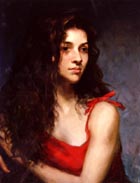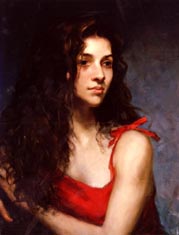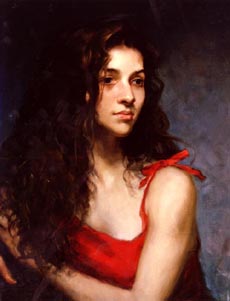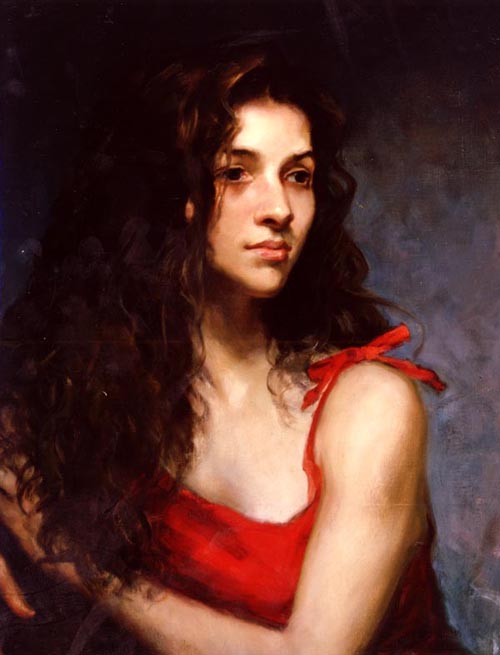|
A
painting
and its
versions of the past
Soares Feitosa
When Teófilo opened the
establishment, there it was, under the door, a picture. Who had put
it there? He remembered of his teachers from the primary school,
whom the boys, he included, would call “teacher”. No. It was not.
“teacher”. No. It was not.
— Only a résumé photograph,
sir. The wind. Who knows, some picture which could have fallen off
the basket – said the assistant who dealt with the folders.
The wind. That was it! What
do the companies do with the résumés which arrive in bulks? After
all, there has been no register of someone who has taken it back.
The letters, the photographs, those were different. But that was not
a photograph. Neither a letter. A painting, appearing to be genteel:
oil on canvas. And in the back, the illegible names of the
painting and of the painter.
— This is not a photograph!
— Teófilo said.
 The
secretary pushed the subject aside. It could have stopped right
there. Some say that Teófilo took the picture and, carefully, kept
it. They say that everyday, he would take the painting and put it on
a huge glass top table, and he would examine it with a magnifying
glass. He would do that again and again. And when he decided that
the size was adequate, he would retouch it using a red pencil, one
of those used to mark Cds, the same pencil which he used to brighten
the labels of the establishment. What was worse was that, when a
costumer arrived, he would immediately ask them if they knew the
young girl. Many of them, due to the repetition of the questionings,
would anticipate themselves, saying, even before bargaining the
price, that they didn’t know the girls in the painting. The
secretary pushed the subject aside. It could have stopped right
there. Some say that Teófilo took the picture and, carefully, kept
it. They say that everyday, he would take the painting and put it on
a huge glass top table, and he would examine it with a magnifying
glass. He would do that again and again. And when he decided that
the size was adequate, he would retouch it using a red pencil, one
of those used to mark Cds, the same pencil which he used to brighten
the labels of the establishment. What was worse was that, when a
costumer arrived, he would immediately ask them if they knew the
young girl. Many of them, due to the repetition of the questionings,
would anticipate themselves, saying, even before bargaining the
price, that they didn’t know the girls in the painting.
— You could have seen her at
the kermis, wouldn’t you?
At the kermis! If there was
any chance of these girls would go to
the kermis. No, nobody would know. She was not found. Others assure
him that the painting had nothing of mysterious and would have even
less to do with a so-called gale, especially because a blow of wind,
with the windows close, would have been impossible. to
the kermis. No, nobody would know. She was not found. Others assure
him that the painting had nothing of mysterious and would have even
less to do with a so-called gale, especially because a blow of wind,
with the windows close, would have been impossible.
It could be other version:
one day, Teófilo reproduced a dream and drafted it in the air. He
drafted it on top of one of his legs, just after waking up. In a
hurry, he ran to the establishment and put it into paper and sent
it, by means of a big reward, to the painter’s society. He even
started a context. He gave instructions, this and that. When the
painting came, a friend remarked that there was any mention
regarding the bottom part in that picture. Really, if you look at
it, you cannot guarantee that the young girl has a body below waist.
“Of
 course
she must have!” Really, there is no one who exists only from the
waist up. What about the rest? How could it be the rest of her body? course
she must have!” Really, there is no one who exists only from the
waist up. What about the rest? How could it be the rest of her body?
Some say that Teófilo, from
the top of his many demands, would not have complained about the
painter’s team, because the indications of the dream would include
anything else besides the upper parts, like it is. Teófilo feared to
demand something else, let’s say, a new painting, containing the
whole body, simply because he was completely taken by the terror of
not “meeting” her, if she appeared in new format, from feet to head.
In the end, he knew only that part. She showed her outline also, but
not so much. Yes, the other sleeve, where it would be? You cannot
see it - her hair is long and thick. Very strange.
Until one day, a bagman
passed on the news about a painter called Allan R. Banks, American,
borne in 1948. The painting? The one mentioned before: Hanna.
Nothing to do with Teófilo’s dream, which would seem more like a
nightmare. The problem is that no-one everbelieved.
Dear reader, please, do not
ask me about the ending. This belongs to the past, something totally
inaccessible, even to the historians. In fact, if two of them were
to meet, just like the literaturecritics, they would immediately
disagree. What could be said of the rumormonger who would shake
Teófilo’s life and his mysterious painting, night and day? The
future, no! This is a peaceful subject, the future. We all know it.
Try to put any question in the future form and the answer will be
instantaneous. That’s why the warlocks and fortune tellers are all
unemployed. Including Teófilo.

Fortaleza, Ceará, Brasil, 2.7.2005, de
noite
|